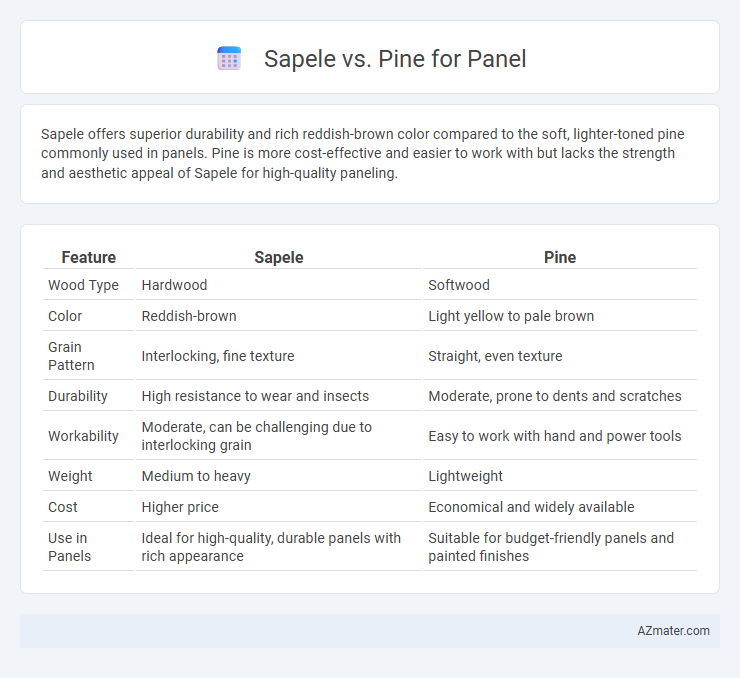Sapele offers superior durability and rich reddish-brown color compared to the soft, lighter-toned pine commonly used in panels. Pine is more cost-effective and easier to work with but lacks the strength and aesthetic appeal of Sapele for high-quality paneling.
Table of Comparison
| Feature | Sapele | Pine |
|---|---|---|
| Wood Type | Hardwood | Softwood |
| Color | Reddish-brown | Light yellow to pale brown |
| Grain Pattern | Interlocking, fine texture | Straight, even texture |
| Durability | High resistance to wear and insects | Moderate, prone to dents and scratches |
| Workability | Moderate, can be challenging due to interlocking grain | Easy to work with hand and power tools |
| Weight | Medium to heavy | Lightweight |
| Cost | Higher price | Economical and widely available |
| Use in Panels | Ideal for high-quality, durable panels with rich appearance | Suitable for budget-friendly panels and painted finishes |
Introduction to Sapele and Pine Panels
Sapele panels are crafted from African mahogany wood, renowned for their rich reddish-brown color, fine grain, and excellent durability, making them ideal for high-quality cabinetry, furniture, and decorative applications. Pine panels, on the other hand, are derived from softwood trees native to the Northern Hemisphere, characterized by a light color, prominent knots, and affordability, commonly used in construction, paneling, and rustic furniture. Both Sapele and Pine panels offer unique aesthetic and functional properties, with Sapele providing enhanced strength and a luxurious finish, while Pine excels in versatility and ease of customization.
Wood Origin and Botanical Background
Sapele wood originates from West Africa, specifically the tropical forests of countries like Nigeria, Ghana, and Cameroon, and belongs to the Meliaceae family, closely related to mahogany. Pine wood comes primarily from the Northern Hemisphere, including North America, Europe, and Asia, and is part of the Pinaceae family, characterized by softwood species used extensively in construction and furniture. The distinct botanical backgrounds influence their physical properties, with Sapele offering hardwood durability and rich reddish hues, while Pine provides lightweight, pale yellow tones ideal for cost-effective and versatile paneling.
Physical Appearance and Grain Characteristics
Sapele features a rich reddish-brown color with a fine, interlocking grain that often displays a natural luster, making it highly sought after for decorative paneling. Pine, on the other hand, exhibits a light yellow to pale cream color with a straight grain that may include knots, offering a more rustic and casual aesthetic. The dense, smooth texture of Sapele contrasts with Pine's softer, more porous surface, influencing both the panel's durability and visual appeal.
Strength and Durability Comparison
Sapele wood offers superior strength and durability compared to pine, making it ideal for heavy-use panel applications. Its dense grain structure provides enhanced resistance to wear, dents, and moisture, whereas pine is softer and more prone to damage and decay over time. Sapele's natural hardness and stability ensure long-lasting panels with minimal maintenance, outperforming pine in durability and structural integrity.
Workability and Ease of Machining
Sapele wood offers excellent workability with a fine, interlocked grain that machines smoothly, producing clean edges and minimal tear-out, making it ideal for panels requiring precision. Pine is softer and easier to machine but tends to be more prone to dents and tear-out due to its open grain and resin pockets, which may affect surface finish quality. For panel applications where machining ease and a refined finish are critical, Sapele provides superior results over Pine.
Cost and Availability Analysis
Sapele wood typically commands a higher price than pine due to its durability and rich reddish-brown hue, making it a more costly option for panels. Pine is widely available and sourced from fast-growing softwood species, resulting in lower costs and easier procurement for large-scale panel projects. The availability of pine in various grades and its abundance in temperate regions make it a budget-friendly choice compared to the more limited and often imported supply of Sapele.
Resistance to Moisture and Environmental Factors
Sapele wood offers superior resistance to moisture and environmental factors compared to pine, making it a preferred choice for paneling in humid or outdoor environments. Its dense grain structure and natural oils provide enhanced durability against warping, swelling, and insect damage. Pine, while more affordable and easier to work with, is more susceptible to moisture absorption and environmental degradation without proper treatment or sealing.
Finishing and Maintenance Requirements
Sapele wood offers a rich, reddish-brown finish that enhances over time with minimal maintenance, requiring only occasional polishing to maintain its natural luster. Pine panels feature a lighter, softer surface that may need more frequent sealing or varnishing to protect against dents and moisture. Both woods benefit from regular dusting, but Sapele's durability reduces the frequency of refinishing compared to Pine, making it a low-maintenance choice for long-lasting aesthetics.
Best Use Cases for Sapele and Pine Panels
Sapele panels excel in high-end cabinetry, furniture, and interior trim due to their rich reddish-brown color, attractive grain patterns, and durability against wear. Pine panels are ideal for budget-friendly interior applications such as wall paneling, ceiling planks, and decorative projects, offering ease of painting and a lighter, natural finish. Sapele is favored for projects requiring aesthetic appeal and strength, while pine suits environments where cost-effectiveness and easy workability are priorities.
Final Verdict: Choosing the Right Wood for Your Panel
Sapele offers a rich, reddish-brown hue with excellent durability and resistance to moisture, making it ideal for high-end panels that require both aesthetic appeal and long-lasting performance. Pine provides a lighter color with a softer texture, offering affordability and ease of workability, suitable for budget-conscious projects or rustic paneling. Selecting between Sapele and Pine depends on balancing desired durability, appearance, and budget, with Sapele excelling in premium applications and Pine favored for cost-effective solutions.

Infographic: Sapele vs Pine for Panel
 azmater.com
azmater.com